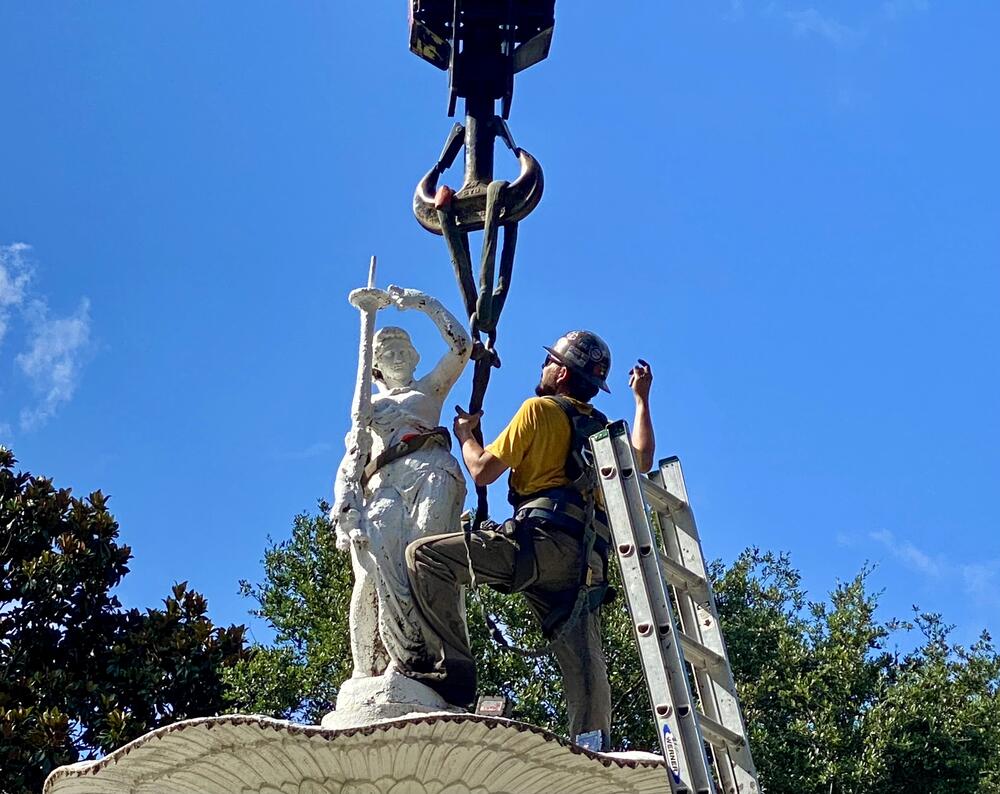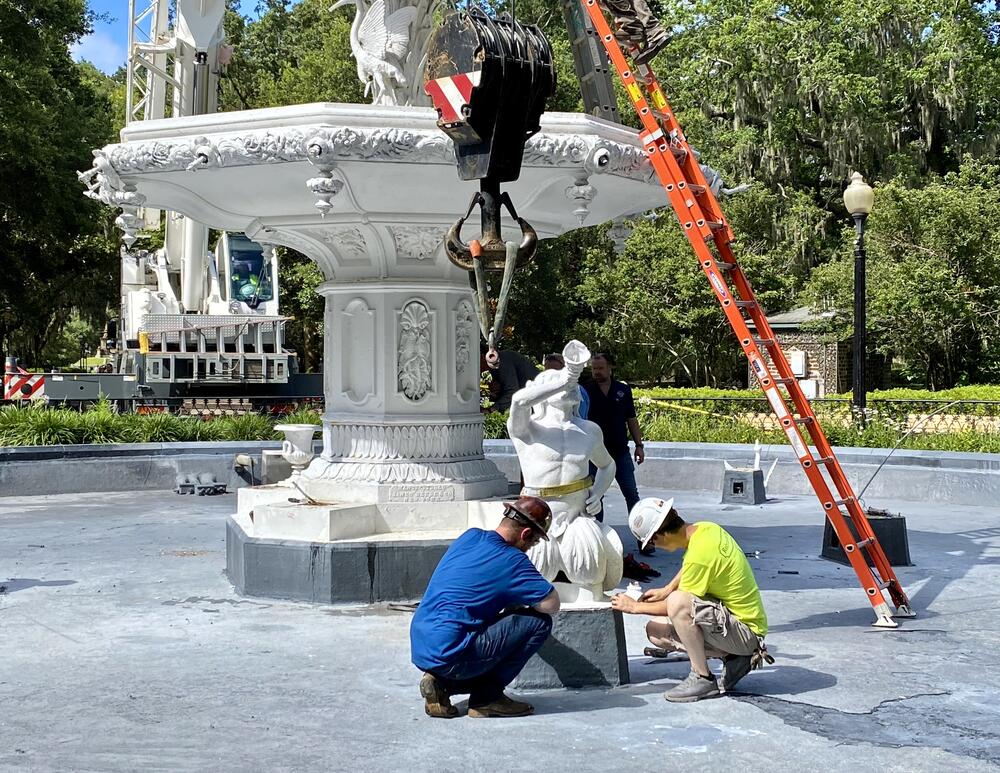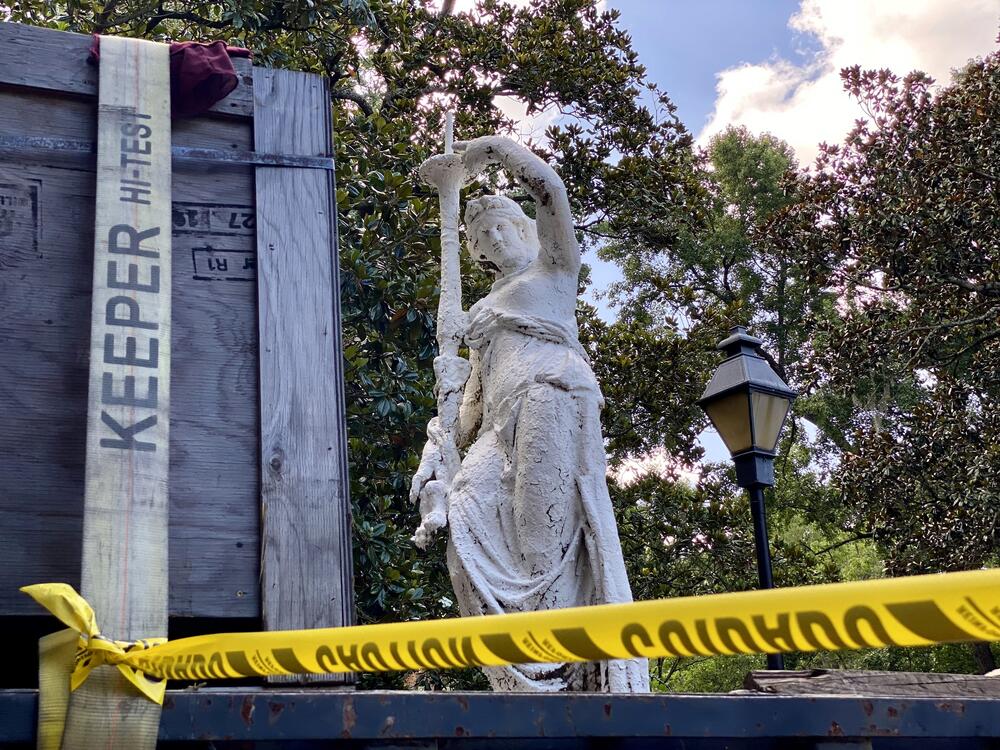
Caption
A worker attaches the Forsyth Park fountain's crowning statue onto a crane for removal on Monday, June 23.
Credit: Benjamin Payne / GPB News
|Updated: June 24, 2025 2:42 PM
LISTEN: Built in 1858, the Forsyth Park fountain will be absent for the first time in more than a century as crews transport each piece to Alabama for restoration. GPB's Benjamin Payne reports.

A worker attaches the Forsyth Park fountain's crowning statue onto a crane for removal on Monday, June 23.
Crews in Savannah began disassembling the city's iconic Forsyth Park fountain on Monday — the first step in a major restoration of the antebellum landmark to help return the fixture to its full glory.
After unscrewing rusty bolts from the fountain's crowning statue of a robed woman wielding a staff, a towering crane carefully hoisted it onto a flatbed truck below as the first piece of the 167-year-old structure to be removed.
Each component of the fountain will be transported to Robinson Iron Corporation in Alexander City, Ala., where craftsmen will sandblast and restore the ornate ironwork before returning it to Savannah for reassembly by the end of the year.
The $650,000 project represents the first major restoration of the Forsyth Park fountain since 1988 and marks the first time in more than 100 years the fountain will be absent from the park.

Workers prepare one of the fountain's four triton statues for removal by crane.
Savannah Park and Tree Department director Gordon Denney said the restoration became necessary after assessments in 2020 and 2024 revealed structural deficiencies that required attention to preserve the fountain for future generations.
"There are a lot of areas that need to be replumbed, recast," Denney said at a press conference Monday. "We had areas that needed to be repainted, obviously. So there's just a lot of items that needed to be done so that we could have it just continue to operate and function optimally for future generations to enjoy."
The fountain's removal is scheduled to be completed by Wednesday, with crews working methodically to protect the fragile cast-iron components during transport.
Luke Robinson — whose family-owned company Robinson Iron also handled the 1988 restoration — described the fountain as coming apart "a lot like Legos, very big, very heavy Legos," with the statuary removed first, followed by bowls and the base.
The fountain's large bowl will be disassembled into panels to avoid classifying it as a "super-wide load" during highway transport, Robinson said, noting that the restoration convoy typically draws attention from motorists during the journey to Alabama.

The fountain's crowning statue sits on a flatbed truck, which will transport it to a repair shop in Alabama.
Landmark Preservation partner Greg Jacobs — whose firm is consulting on the project — said the restoration will reveal details hidden beneath nearly four decades of paint accumulation.
"It's going to look a lot crisper," he said. "With nearly 40 coats of paint, you can expect that a lot of the detail has been lost. So, removing that alone is going to give this such more depth and more character. You're going to be able to see the details."
Originally modeled after a design by J.P. Iron Foundry near Paris and ordered from the Janes, Beebe & Co. catalog as "Model #5," the fountain was first installed in July 1858 and turned on the following August.
Over the decades, the structure has evolved from its original cast-iron construction to include bronze, aluminum and zinc components, reflecting various maintenance efforts and modifications throughout its history.
Landmark Preservation partner John Ecker said the restoration will also address functionality issues, ensuring that decorative elements like tritons and swans work properly to create the intended spray patterns.
The project involves not only the fountain's metalwork but also restoration of the basin's masonry, surrounding fence, water pumphouse, plumbing and electrical systems.
City officials have cleared the special events calendar around the fountain area during the restoration period and plan to install informational plaques explaining the project's history and progress to visitors.
Brent Boyd, division director of the city's Historic Parks and Monuments Division, said summer timing was chosen deliberately to avoid weather-related complications with restoration materials and to minimize disruption during Savannah's peak tourism seasons in spring and fall.
Robinson Iron will carefully disassemble, recast, and restore the fountain's original cast-iron components at their Alabama facility, where craftsmen will sandblast each piece down to bare metal before determining which elements can be reused and which require recasting.
The restoration timeline anticipates completion by early fall, pending any unexpected delays discovered during the disassembly and restoration processes.
For Robinson — whose company has worked on notable fountains including the Bartholdi Fountain in Washington, D.C., and projects as far away as Singapore — the Forsyth Park fountain holds special significance.
"This is probably the most iconic fountain in the country," Robinson said. "It's incredibly unique. You don't run up on this type of fountain very often, if ever."
As restoration work progresses, the city plans to provide regular updates through its website and social media channels, with officials promising transparency about any discoveries made during the paint removal and component analysis phases.